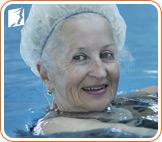Swimming can provide a wealth of benefits, regardless of your level of ability. This sport is not just for young kids or Olympic champions, and its benefits can have a fantastic impact on physical well-being. Read on to learn about the benefits of swimming during postmenopause.
Weight Loss

As estrogen levels decline during menopause, hormones become unbalanced, which can often lead to weight gain. Many women can find it difficult to drop these added pounds, as weight loss is even harder during the transition to postmenopause. Physical exercise - along with a healthy diet - helps to control body weight, as the body exerts more energy than it takes in. Swimming is a great way to burn calories, shed unwanted weight, increase energy, and feel more balanced.
Body Conditioning
As swimming works all the major muscle groups simultaneously, it reduces the risk of overdeveloping muscles in one area, such as the upper or lower body. When you swim, muscle tone and weight loss can occur at an even rate and be well-distributed throughout the body.
Increased Cardiovascular Endurance and Lower Blood Pressure
Swimming increases the heart's capacity to move oxygen through the body. Repeated training will strengthen your heart and lessen the strain on it during times of stress. Regular exercise also helps to reduce overall blood pressure, which reduces the risk of cardiovascular disease, stroke, and heart attack.
Low-impact Exercise
Activities like running, aerobics, and other sports can have a tougher impact on the body, especially for those suffering from muscle or joint pain. Swimming is a great, low-impact alternative that still allows you to reap all the benefits of regular exercise.
Bone Maintenance

Women usually start losing bone mass in their mid-thirties. Only 15% of bone loss is attributed to decline in estrogen levels. Swimming helps build bone density, which can in turn help reduce the risk of bone loss and osteoporosis during the transition to postmenopause.
Pain Reduction
Swimming can help chronic sufferers of diseases like arthritis alleviate pain while increasing joint flexibility.
Swimming can produce immensely positive effects throughout your lifetime. Regular swimming builds endurance, muscle strength, and cardiovascular fitness. It can serve as a cross-training element to regular workouts, and with increasing effort, it can gradually increase your energy, strength, and flexibility.
Click on the following link to learn more about other ways to deal with postmenopause.
Sources
- Centers for Disease Control and Prevention. (2013). Health Benefits of Water-based Exercise. Retrieved January 12, 2016, from http://www.cdc.gov/healthywater/swimming/health_benefits_water_exercise.html
- Love, S. (2003). Menopause and Hormone Book. New York: Three Rivers Press.



